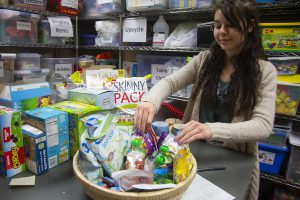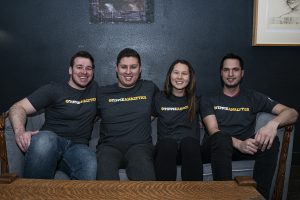Iowa City schools help paint a portrait of a graduate through program to improve students’ post-education skills
The Iowa City Community School District recently launched the Portrait of a Graduate program, allowing the community to offer up ideas about what skills students should be taught in preparation for life after high-school graduation.
The Iowa City Community School District sign is seen on April 29, 2019.
February 24, 2020
The Iowa City Community School District launched the Portrait of the Graduate program this year in partnership with Battelle for Kids to receive feedback from the community on what skills students need post-high school graduation.
The program is centered around providing students with knowledge extending beyond the classroom graduation requirements that will prepare them for life in higher education or a workplace setting.
School District Superintendent Stephen Murley said this project will rely on comments and suggestions from the community. He said school leaders reached out to local business owners, faith leaders, social services, and students for a diverse array of perspectives.
“As a school district, we have a mission and a vision,” Murley said. “A mission is why we exist, and the vision is how we implement it. To do that, we are going to need not only Battelle for Kids’ input, but the community input. What do they think?”
Murley said he was excited to see current and former students signing up to participate in the project.
“We have [current] students all the way down to seventh graders, and former students from Kirkwood, the University of Iowa, and those within the workforce,” he said. “Students have a loud voice in this process, and what they think their education looks like and what it should look like.”
One-hundred-fifty people have signed up to be a part of this project. There will be four meetings, one each month from February to May, in which the community members will get together and discuss what they believe students need to know to formulate the portrait, Murley said.
“The world looks a lot different than it used to,” he said. “We want people to look forward five, 10, 15 years and see what we want our children to be able to do.”
RELATED: Iowa City schools require new personal finance course after state financial-literacy requirement
Iowa City Area Development Group Interim President Kate Moreland, who will be a business representative on the portrait’s design team, said this was an important project to prepare students for fluctuating career paths.
“From a business perspective, these kids are the workforce of the future,” Moreland said. “Kids will change careers, and they need to be flexible problem solvers.”
She said practicing these skills comes down to entrepreneurship and giving them a chance to fail and solve problems effectively will help them down the road. The business community will suggest that students learn hard and soft skills that could better prepare them for the workforce, she said.
“Students should have an opportunity to learn technical and computational skills,” Moreland said. “The K-12 system can prepare them for areas where technology is driving. Having a chance to practice these skills in an everyday setting will help them be more successful in their line of work.”
The University of Iowa College of Education is working with Iowa City schools on this project, Murley said, because it recognizes the importance of preparing future students with skills for higher education. He said the UI President’s Office donated $28,000 to this project and received $5,000 from Battelle for Kids.
“It’s not just a K-12 issue, it’s a higher-education issue, as well,” he said. “We want to talk about what it is going to look like for kids who are going into postsecondary education.”
UI College of Education Dean Daniel Clay said in an email to The Daily Iowan that the UI is a primary stakeholder in this process. The university will educate teachers, psychologists, administrators, and counselors on the best ways to execute the skills the project provides for, he said.
“We must help education professionals prepare for a diverse workplace, rapidly changing technologies, and the increased challenges of mental-health issues in school-aged children,” Clay said.
He said this project will focus on more than just learning content but will include helping students gain skills in collective problem solving, collaboration, and effective social-emotional skills.
Moreland said reaching out to all members of the community will help the school make the best decisions for the way students are taught.
“I think we will hear great ideas from teachers, especially,” she said. “As a partner in the business [community], this will allow us to be more connected to our classrooms. We need to engage with educators and students. Schools cannot do this alone.”






